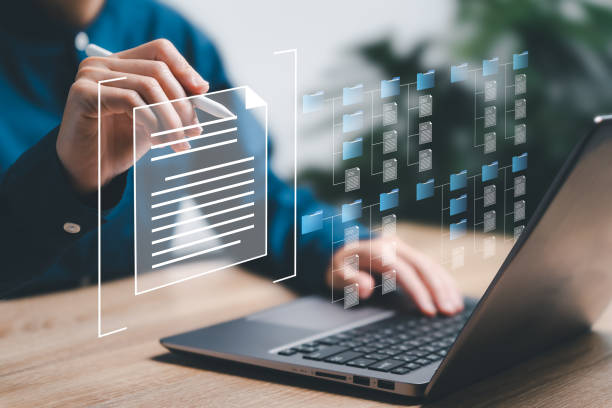### What is On-Page SEO and Why is it Important?
[Image of a businessman touching a magnifying glass with the text “SEO”]
On-Page SEO refers to a set of actions you take within your own website to improve your site’s ranking in search engines like Google Google.
These actions include optimizing content, site structure, HTML tags, and other site-related elements.
The importance of On-Page SEO stems from the fact that it helps search engines better understand the content of your site and display it to relevant users.
Without proper On-Page SEO, even with great content, your site may not be seen in search results.
In general, On-Page SEO plays a vital role in increasing organic traffic and improving the user experience of the site.
In fact, On-Page SEO is the foundation for your website’s visibility in the online world. By using appropriate #keywords and optimizing meta tags and site structure, you can improve your ranking.
In today’s #digital_marketing, On-Page SEO is considered one of the most important factors.
>Are you losing business opportunities because of an outdated website? With Rasaweb, solve the problem of not attracting potential customers through your website forever!
>
>✅ Attract more high-quality leads
>
>✅ Increase brand credibility in the eyes of customers
>
>⚡ Get a free corporate website design consultation
### Keyword Research: Finding the Best Opportunities
[Image related to search engine optimization]
Keyword research is one of the most basic and important steps in On-Page SEO.
The purpose of this research is to find the words that users use to search for information related to your business.
By identifying these words, you can optimize your content to appear in relevant search results.
There are various tools available for keyword research, including Google Keyword Planner, Ahrefs, and Semrush.
To begin, make a list of keywords related to your business and then use these tools to check search volume, competition, and similar keywords.
Focus on words that have a good search volume and aren’t overly competitive.
Using Long-Tail Keywords can also help you attract more targeted traffic.
Long-Tail Keywords are longer, more specific phrases that usually have lower search volumes but higher conversion rates.
### Optimizing Titles and Meta Descriptions
[Image related to digital marketing development and goals strategy]
Titles and meta descriptions are the first things users see in search results, so optimizing them is essential to attract clicks.
Titles should be engaging, concise, and include the main keyword.
The length of titles should usually be less than 60 characters so they are fully displayed in search results.
Meta descriptions are summaries of the page’s content and should encourage users to click on your link.
The length of meta descriptions should usually be between 150 and 160 characters.
In the meta description, in addition to the main keyword, use related keywords and engaging phrases.
Remember that titles and meta descriptions should be unique for each page to avoid creating duplicate content.
By properly optimizing titles and meta descriptions, you can increase your click-through rate (CTR) and attract more traffic to your site.
**On-Page SEO** is very important at this stage.
“`
.table-container {
overflow-x: auto;
}
table {
border-collapse: collapse;
width: 100%;
border: 1px solid #ddd;
}
th, td {
text-align: left;
padding: 8px;
border: 1px solid #ddd;
}
th {
background-color: #f2f2f2;
}
tr:nth-child(even) {
background-color: #f2f2f2;
}
“`
| Title | Description | Example |
| ——————– | —————————————————————— | ———————————————————————– |
| Optimized Title | Includes the main keyword, engaging, less than 60 characters | Buy the best Samsung mobile phone with a special discount |
| Optimized Meta Description | Summary of the page’s content, persuasive, between 150-160 characters | Expert review of the latest Samsung phones with comparison and online shopping. Free shipping nationwide! |
Click here to preview your posts with PRO themes ››
### Optimizing Images: Increasing Speed and SEO
[Image relating to CPI consumer price index]
Images play an important role in attracting user attention and improving user experience, but improper use of images can slow down your site and negatively impact SEO.
To optimize images, first reduce the file size of the images.
You can use online tools like TinyPNG or ImageOptim to compress images.
Also, use appropriate formats for images.
JPEG format is better for images with many colors, and PNG format is better for images with simple graphics.
Another important point is to use Alt tags for images.
Alt tags help search engines understand the content of images and display them in search results.
In the Alt tag, use a keyword related to the image and provide a brief and accurate description of the image content.
Image file names should also be relevant and descriptive.
For example, instead of a name like IMG_1234.jpg, use a name like samsung-galaxy-s23.jpg.
By following these tips, you can optimize your images and increase your site speed.
>Still don’t have a corporate website and are missing out on online opportunities? With professional corporate website design by Rasaweb,
>
>✅ Double your business credibility
>
>✅ Attract new customers
>
>⚡ Free consultation for your corporate website!
### URL Structure: Creating SEO-Friendly Links
[Image related to digital marketing for product promotion]
URL structure is an important factor in On-Page SEO that is often overlooked.
Optimized URLs should be short, descriptive, and include the main keyword.
Avoid using unnecessary characters and numbers in URLs.
For example, instead of a URL like example.com/page?id=123, use a URL like example.com/seo-internal-guide.
The URL structure should be logical and hierarchical.
This helps users and search engines easily navigate your site.
Use appropriate categories for your pages and organize URLs based on categories.
For example, if you have an online store, the URLs of product pages should include the category name and product name.
**On-Page SEO** helps you build a better structure for your site.
Also, make sure you are using HTTPS.
HTTPS is a secure protocol that encrypts information between the user’s browser and the site’s server.
Google gives higher rankings to sites that use HTTPS.
### Optimizing Site Speed: Better User Experience and Higher Ranking
[Image related to finding work]
Site speed is a key factor in user experience and SEO.
Faster sites have lower bounce rates and attract more users.
Google also gives a better ranking to sites that have high speeds.
To optimize site speed, first check your site speed using tools like Google PageSpeed Insights or GTmetrix.
These tools will show you what factors are slowing down your site.
Then, take steps to improve your site speed.
These steps include compressing images, enabling browser caching, using content delivery networks (CDNs), optimizing HTML and CSS code, and using fast hosting.
Also, use a lightweight and optimized template for your site and avoid installing unnecessary plugins.
**On-Page SEO** can ultimately help improve your site speed.
### High-Quality Content: Creating Value for Users and Search Engines
[Image related to concept of seo analysis and business]
Content is king! This statement still holds true in the world of SEO.
High-quality and valuable content attracts users, keeps them on your site, and helps increase your site’s ranking in search engines.
Your content should be unique, comprehensive, accurate, and up-to-date.
Use relevant keywords in your content, but avoid overusing keywords.
Focus on providing useful and valuable information to users.
Use engaging titles and subtitles to organize your content and use images, videos, and other visual elements to make your content more attractive.
Update your content regularly and add new and relevant content to your site.
**On-Page SEO** helps your content get seen better.
Click here to preview your posts with PRO themes ››
“`
.table-container {
overflow-x: auto;
}
table {
border-collapse: collapse;
width: 100%;
border: 1px solid #ddd;
}
th, td {
text-align: left;
padding: 8px;
border: 1px solid #ddd;
}
th {
background-color: #f2f2f2;
}
tr:nth-child(even) {
background-color: #f2f2f2;
}
“`
| Feature | Description |
| ———— | ———————————————————- |
| Unique | Content should not be copied from other sites. |
| Comprehensive | Cover all aspects of the topic. |
| Accurate | The information provided should be correct and up-to-date. |
| Up-to-date | Content should be updated regularly. |
### Internal Linking: Guiding Users and Search Engines
[Image related to document management system being set up]
Internal linking refers to creating links between different pages of your site.
Internal linking helps users easily navigate your site and find more information.
It also helps search engines better understand your site structure and identify more important pages.
When internal linking, use relevant and descriptive text for the links.
For example, instead of using the text “Click here,” use the text “Comprehensive guide to **On-Page SEO**.”
Link to relevant and valuable pages, and avoid over-linking to a single page.
**On-Page SEO** becomes stronger with the use of strong internal linking.
Also, avoid linking to broken pages (404).
Internal linking is an important strategy in On-Page SEO that can help improve your site’s ranking in search engines.
>Did you know that your company’s website is the first point of contact for 75% of potential customers?
>
>Your website is the face of your brand. With corporate website design services from **Rasaweb**, create an online presence that earns customer trust.
>
>✅ Create a professional and lasting image of your brand
>
>✅ Attract target customers and increase online credibility
>
>⚡ Get a free consultation from **Rasaweb** experts!
### Optimizing for Mobile: Providing a Great User Experience on Different Devices
[Image related to artificial intelligence analytics software]
With the increasing use of mobile devices to search the Internet, optimizing your site for mobile is especially important.
Google gives higher rankings to sites that are optimized for mobile.
To optimize your site for mobile, use a Responsive Design.
Responsive Design means that your site automatically adapts to the screen size of different devices.
Check your site speed on mobile devices and take steps to improve your site speed on mobile.
Use readable fonts and large buttons so users can easily navigate your site.
Avoid pop-up content and intrusive advertisements. **On-Page SEO** helps you design a website with responsive capabilities.
By optimizing your site for mobile, you can provide a better user experience for mobile users and increase your site’s ranking in search engines. Mobile **On-Page SEO** is very important.
### Sitemap and Robots.txt File
[Image relating to big data information content network]
A Sitemap is an XML file that lists all the pages of your site.
The sitemap helps search engines easily find and index all the pages of your site.
The Robots.txt file is a text file that tells search engines which pages of your site to index and which pages not to index.
By using the Robots.txt file, you can prevent unnecessary and duplicate pages from being indexed.
Creating a Sitemap and Robots.txt file is an important step in optimizing your site for search engines.
Register your Sitemap in Google Search Console so that Google can easily find your Sitemap.
Use online tools to create a Sitemap and Robots.txt file.
A sitemap helps to improve the **On-Page SEO** of your site.
Also, check your sitemap regularly and update it if needed.
This ensures that search engines always have accurate information about your site structure.
Click here to preview your posts with PRO themes ››
#### Frequently Asked Questions
| Question | Answer |
| ————————————————————— | ———————————————————————————————————————————————————————————————————————————————————————————————————————————————————————————————————————————————————————————————————————————————————————————————————– |
| What is On-Page SEO? | On-Page SEO involves optimizing elements that are directly under your control and within your website. The goal is to help search engines better understand the content of the page and improve its ranking. |
| Why is On-Page SEO important? | On-Page SEO gives search engines clear signals about the content of the page, improves user experience, and increases the chances of attracting organic traffic. |
| What are the most important On-Page SEO factors? | Keywords, Title Tag, Meta Description, URL structure, high-quality content, image optimization, and internal links are among the most important factors. |
| What is the role of the Title Tag in On-Page SEO? | The title tag is one of the most important signals for search engines and users that identifies the main topic of the page. It should include the main keyword and be engaging. |
| How important is the Meta Description? | The meta description does not directly affect rankings, but by encouraging users to click, it can improve the click-through rate (CTR). |
| How do we optimize images for On-Page SEO? | By using a descriptive file name, appropriate Alt Text containing keywords, compression to reduce volume, and correct dimensions. |
| What effect do Internal Links have on SEO? | Internal links help search engines discover and index site pages, distribute authority (PageRank) across the site, and improve user navigation. |
| Is page load speed part of On-Page SEO factors? | Yes, page load speed is a critical factor in On-Page SEO and user experience. Slower pages can lead to higher bounce rates and lower rankings. |
| What features does quality content have for On-Page SEO? | Quality content should be comprehensive, unique, relevant, reliable, readable, and fully answer the needs and questions of users. |
| How can keywords be used in content? | Keywords should be used naturally in the title, subheadings, first paragraph, body text, and alt text of images. Avoid Keyword Stuffing. |
**And other services of Rasa Web advertising agency in the field of advertising**
**Smart Google Ads: An effective tool for user engagement through Google Ads management.**
**Smart Social Media: Professional optimization to increase sales using Google Ads management.**
**Smart Sales Automation: Professional optimization for online growth using user experience customization.**
**Smart UI/UX: A professional solution to increase sales by focusing on attractive user interface design.**
**Smart Digital Advertising: An effective tool to attract customers by designing an attractive user interface.**
**And more than hundreds of other services in the field of internet advertising, advertising consulting and organizational solutions**
**Internet Advertising | Advertising Strategy | Advertorials**
**Are you ready to jumpstart your business in the digital world? Rasaweb Digital Marketing Agency, with expertise in SEO, content marketing and responsive website design, is with you to reach the peak.**
**📍 Tehran, Mirdamad Street, next to the Central Bank, Kazerun Jonoubi Alley, Ramin Alley No. 6**
**✉️ info@idiads.com**
**📱 09124438174**
**📱 09390858526**
**📞 02126406207**
#### Resources
[SEO Beginner’s Guide](https://www.seoclarity.net/blog/seo-basics-guide)
,[Ahrefs On-Page SEO Guide](https://ahrefs.com/blog/on-page-seo/)
,[Moz On-Page Optimization](https://moz.com/learn/seo/on-page-optimization)
,[Yoast On-Page SEO](https://yoast.com/on-page-seo/)




